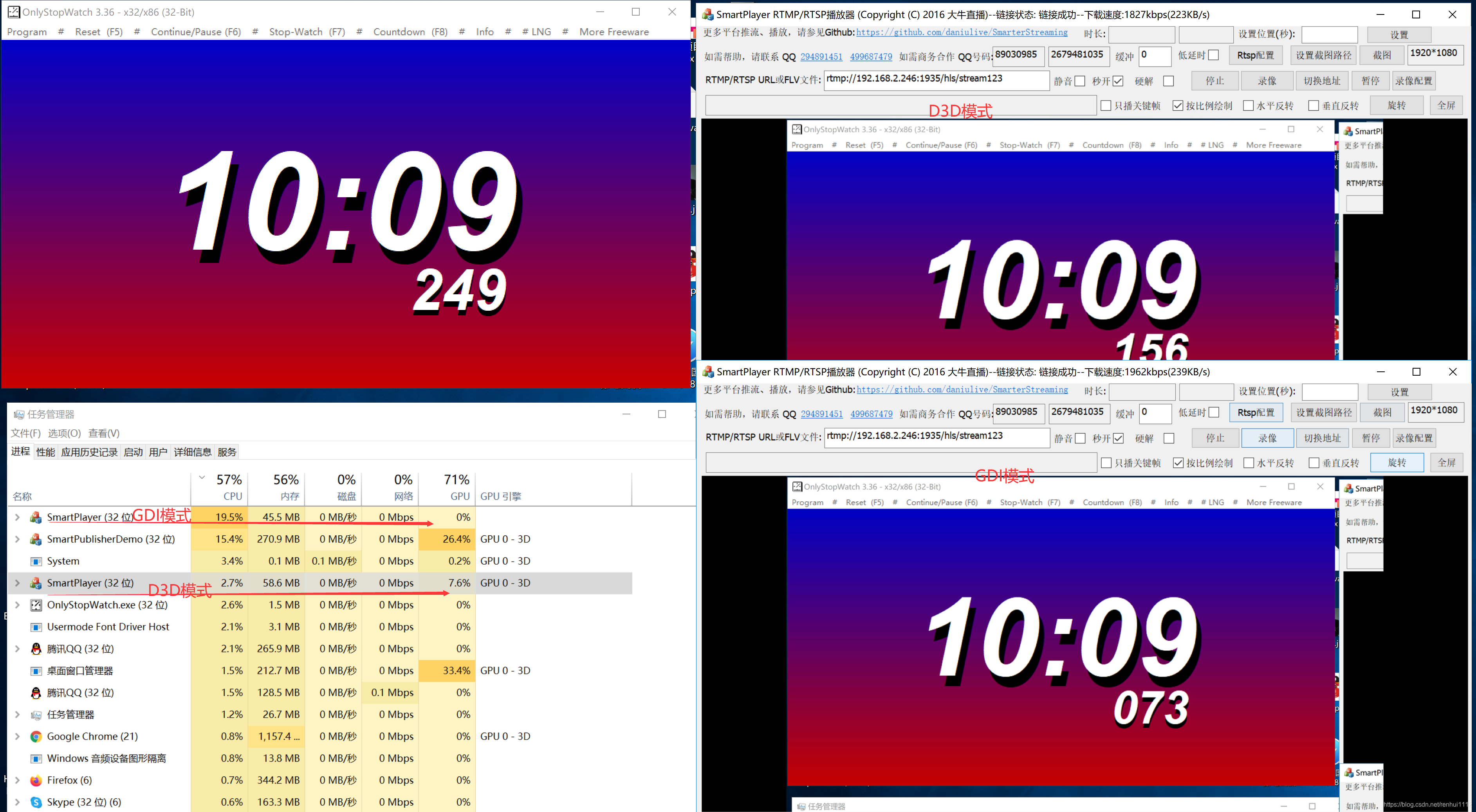先说结论,Windows平台播放渲染这块,支持D3D的前提下,优先D3D,如果检测到不支持D3D,数据回调上来,GDI模式绘制。
相比GDI模式,D3D绘制更细腻,绘制效率更高,CPU占用低,只要是系统检测支持,一般建议D3D模式。
无图无真相:

本文以1920*1080分辨率、30帧、固定码率(采集屏幕左侧区域)为例,通过大牛直播SDK ( github) 的Windows平台SmartPublisherDemo.exe工具推送到内网nginx服务器,然后分别以D3D模式和GDI模式拉流(播放端缓冲设置为0)。
可以看到:
D3D模式,CPU占用只有2.7%,延迟:249-156 = 93ms;
GDI模式,CPU占用19.5%,延迟249-73 = 176ms。
无论是从延迟和CPU占用上看,D3D模式都占优。
实现思路:
以C#的demo为例:
1. 先检测系统是否支持D3D模式:
if (NT.NTBaseCodeDefine.NT_ERC_OK == NTSmartPlayerSDK.NT_SP_IsSupportD3DRender(player_handle_, playWnd.Handle, ref in_support_d3d_render)){if (1 == in_support_d3d_render){is_support_d3d_render = true;}}2. 如不支持D3D,数据回到上层,做绘制:
if (is_support_d3d_render){is_gdi_render_ = false;// 支持d3d绘制的话,就用D3D绘制NTSmartPlayerSDK.NT_SP_SetRenderWindow(player_handle_, playWnd.Handle);if (btn_check_render_scale_mode.Checked){NTSmartPlayerSDK.NT_SP_SetRenderScaleMode(player_handle_, 1);}else{NTSmartPlayerSDK.NT_SP_SetRenderScaleMode(player_handle_, 0);}}else{is_gdi_render_ = true;playWnd.Visible = false;// 不支持D3D就让播放器吐出数据来,用GDI绘制//video frame callback (YUV/RGB)//format请参见 NT_SP_E_VIDEO_FRAME_FORMAT,如需回调YUV,请设置为 NT_SP_E_VIDEO_FRAME_FROMAT_I420video_frame_call_back_ = new SP_SDKVideoFrameCallBack(SetVideoFrameCallBack);NTSmartPlayerSDK.NT_SP_SetVideoFrameCallBack(player_handle_, (Int32)NT.NTSmartPlayerDefine.NT_SP_E_VIDEO_FRAME_FORMAT.NT_SP_E_VIDEO_FRAME_FORMAT_RGB32, IntPtr.Zero, video_frame_call_back_);} public void SetVideoFrameCallBack(IntPtr handle, IntPtr userData, UInt32 status, IntPtr frame){if (frame == IntPtr.Zero){return;}//如需直接处理RGB数据,请参考以下流程NT_SP_VideoFrame video_frame = (NT_SP_VideoFrame)Marshal.PtrToStructure(frame, typeof(NT_SP_VideoFrame));NT_SP_VideoFrame pVideoFrame = new NT_SP_VideoFrame();pVideoFrame.format_ = video_frame.format_;pVideoFrame.width_ = video_frame.width_;pVideoFrame.height_ = video_frame.height_;pVideoFrame.timestamp_ = video_frame.timestamp_;pVideoFrame.stride0_ = video_frame.stride0_;pVideoFrame.stride1_ = video_frame.stride1_;pVideoFrame.stride2_ = video_frame.stride2_;pVideoFrame.stride3_ = video_frame.stride3_;Int32 argb_size = video_frame.stride0_ * video_frame.height_;pVideoFrame.plane0_ = Marshal.AllocHGlobal(argb_size);CopyMemory(pVideoFrame.plane0_, video_frame.plane0_, (UInt32)argb_size);if (playWnd.InvokeRequired){BeginInvoke(set_video_frame_call_back_, status, pVideoFrame);}else{set_video_frame_call_back_(status, pVideoFrame);}}具体绘制代码:
private void SmartPlayerForm_Paint(object sender, PaintEventArgs e){if (player_handle_ == IntPtr.Zero || !is_gdi_render_ || !is_playing_){return;}if (cur_video_frame_.plane0_ == IntPtr.Zero){return;}Bitmap bitmap = new Bitmap(cur_video_frame_.width_, cur_video_frame_.height_, cur_video_frame_.stride0_,System.Drawing.Imaging.PixelFormat.Format32bppRgb, cur_video_frame_.plane0_);int image_width = cur_video_frame_.width_;int image_height = cur_video_frame_.height_;Graphics g = e.Graphics; //获取窗体画布g.SmoothingMode = SmoothingMode.HighSpeed;int limit_w = this.Width - 60;int limit_h = this.Height - playWnd.Top - 60;if (btn_check_render_scale_mode.Checked){int d_w = 0, d_h = 0;int left_offset = 0;int top_offset = 0;Brush brush = new SolidBrush(Color.Black);g.FillRectangle(brush, playWnd.Left, playWnd.Top, limit_w, limit_h);GetRenderRect(limit_w, limit_h, image_width, image_height, ref left_offset, ref top_offset, ref d_w, ref d_h);g.DrawImage(bitmap, playWnd.Left + left_offset, playWnd.Top + top_offset, d_w, d_h); //在窗体的画布中绘画出内存中的图像}else{g.DrawImage(bitmap, playWnd.Left, playWnd.Top, limit_w, limit_h); //在窗体的画布中绘画出内存中的图像}}目前来看,不支持D3D的机器少之又少,在环境具备的情况下,优先建议考虑D3D模式绘制。

















